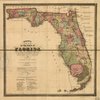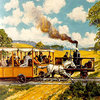Decennial Census Historical Facts
Decennial Census Historical Facts
Censuses are not conducted in a vacuum. They occur amidst internal and external crisis, shifts in cultural interests, and events that become "defining moments" for each decade. Census data reflect the growth of the population as well as the changing values and interests of the American people.
Decennial Historical Facts provides a portrait of the United States both statistically and culturally in the following four areas:
- Pop Culture – key milestones from the decade following the census.
- Population
- Census Details
- 10 Largest Urban Places
1820
ICONS: Spain Cedes Florida, Baltimore & Ohio Railroad, Smithsonian Institution



Population
| 9,638,453 | U.S. Resident Population |
| 7.4 |
Population per square mile of land area |
| 33.1 |
Percent increase of population from 1810 to 1820 |
| 23 |
Number of States |
10 Largest Urban Places
| Rank |
Place |
Population |
|---|---|---|
| 1 |
New York City, NY | 123,706 |
| 2 |
Philadelphia, PA | 63,802 |
| 3 |
Baltimore, MD | 62,738 |
| 4 |
Boston town, MA | 43,298 |
| 5 |
New Orleans, LA | 27,176 |
| 6 |
Charleston, SC | 24,780 |
| 7 |
Northern Liberties township, PA | 19,678 |
| 8 |
Southwark district, PA | 14,713 |
| 9 |
Washington, DC | 13,247 |
| 10 |
Salem town, MA | 12,731 |
The 1820 Census
| Cost | $209,000 |
| Cost per Capita (cents) | 2.2 |
| Total Pages in Published Reports | 228 |
| Number of Enumerators | 1,188 |
| Census Bureau Director | John Quincy Adams |
| Number of Questions on the Questionnaire | 7 |
| Number of Questions on the Long Form | N/A |
Pop Culture
- Colonel Robert Gibbon Johnson proves that tomatoes are not poisonous by eating one in public on September 28, 1820.
- On November 20, 1820, the Nantucket, MA, whaling ship Essex sinks after being attacked by a sperm whale. The event inspires Herman Melville's 1851 novel, Moby Dick.
- The Adams-Onís Treaty is ratified in 1821, in which Spain ceded Florida to the United States in exchange for America's renunciation of any claims on Texas following the Louisiana Purchase and $15 million.
- The Saturday Evening Post is published for the first time as a weekly newspaper on August 4, 1821.
- During his State of the Union Address on December 2, 1823, President James Monroe introduces the "Monroe Doctrine" declaring that European attempts to recolonize the Americas would be considered a hostile act towards the United States.
- Although Andrew Jackson wins the popular vote, the 1824 presidential election is decided by the U.S. House of Representatives when none of the four candidates (John Quincy Adams, Andrew Jackson, William H. Crawford, and Henry Clay) wins a majority of the electoral votes. The House chooses Adams on February 9, 1825.
- The first boat leaves Buffalo, NY, enroute to New York City via the Erie Canal on October 26, 1825.
- Samuel Morey patents the internal combustion engine (named the "Gas or Vapor Engine") on April 1, 1826.
- Thomas Jefferson and John Adams die on July 4, 1826, the 50th anniversary of the signing of the Declaration of Independence.
- The Baltimore and Ohio Railroad incorporates - becoming the first railroad in the United States to offer transportation for people and commercial goods - on February 28, 1827.
- In 1829, Presbyterian minister Reverend Sylvester Graham develops "Dr. Graham's Honey Biskets," later known as "Graham Crackers."
- The Smithsonian Institution is founded in 1829 when British scientist James Smithson bequeaths $500,000 for its initial funding.
Page Last Revised - October 8, 2021




